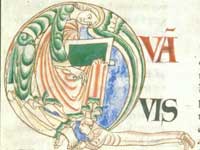|
You are here:
The key Cistercian sources
(1/1)
1. Narrative accounts
of the early history of the Order
(a) Exordium Cistercii: a brief narrative of the early history
of the Order, that ends in 1115.
(b) Exordium Parvum Cistercii: which is essentially the Exordium
Cisterciensis Coeniobii: it includes the early history of Cîteaux,
incorporating official letters and documents with narrative. The
Exordium Parvum was expanded and revised in c. 1147, the
version that we now have.
2. The Cistercian constitution, the Carta
Caritatis (the Charter of Charity)
This was a pioneering document that established the constitutional
framework of the Order; it outlined the federal arrangement of the
abbeys which were bound in ties of unity and subject to annual visitation.
Every abbey was to have a copy of this document. The Carta Caritatis
was frequently updated; the earliest version, compiled c. 1114,
is no longer extant. It was approved by Pope Calixtus II in 1119.
3. The Capitula (Statutes of the General
Chapter)
These disciplinary decrees, thematically arranged, constituted the
first code of law issued by the General
Chapter. Whilst some of the statutes date from Stephen
Harding’s abbacy (pre-date c. 1133-4), the process of development
was gradual. The statutes of the General Chapter from 1116-1786
have been edited, in eight volumes, by Canivez.(1)
4. The Ecclesiastica Officia
A directory of regulations regarding liturgical and monastic life.
It is not known when the first version was completed, although this
was likely soon after 1119, during Stephen Harding’s abbacy. The
Ecclesiastica Officia was essentially a reference book to
ensure uniformity amongst the abbeys; it details how the liturgy
should be celebrated and the house administered.(2)
5. The Usus Conversorum(3)
The customs relating to the lay-brothers.
The Cistercians were the first to fully legislate for the lay-brothers.
This twelfth-century text comprises of a prologue and twenty-three
chapters that address clothing, communion etc. The first version
of this work probably post-dates the earliest version of the Ecclesiastica
Officia, and was likely compiled in the early 1120s.(4)
6. Compilations
(a) The Usages (Usus cisterciensium), c. 1133-5
(b) The Customs (Consuetudines cisterciensium), c. 1152
Both compilations included an historical prologue (either the Exordium
Cistercii or the Exordium Parvum), a version of the Carta
Caritatis (the Charter of Charity), the Capitula of the
General Chapter, the Ecclesiastica Officia and the Usus
Conversorum.
<back><next>
|








